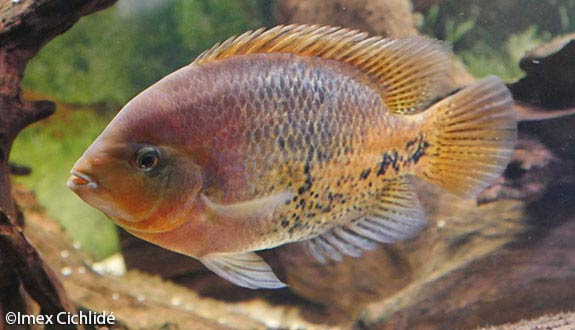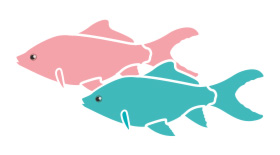

Redhead cichlid
(Vieja synspila)

A big thank you to Imex Cichlidé!
Alternative species (click on the thumbnail to see the card)
Names
Scientific name
Vieja synspila
Vieja melanura
Paraneetroplus synspilus
Common name
Redhead cichlid
Quetzal cichlid
Firehead cichlid
Origin

Origin: Central America (Mexico, Guatemala, Belize)
Biotope: American
Dimorphism

The male presents more vivid colours and develops a frontal hump absent in the female
Group

Cichlidae
Volume

600 L / 132 imp gal / 158 US gal in specific
1000 L / 220 imp gal / 264 US gal in community
Parameters

T°: 24 à 28°C or 75 to 82°F
pH: 7 to 8
Hardness: /
Difficulty

Hard
Size

female 35cm (14") - male 40cm (16")
Longevity

10 years
Living zone

Everywhere
Individuals

Couple
Food
How to feed the Redhead cichlid?
Food
How to feed the Redhead cichlid?
Redheads cichlids are omnivorous, they eat everything.
It is a fish that needs a lot of plants in its diet, it will gladly take all the plants of the aquarium for salad.
Nevertheless, it likes fish, shrimp and mussels like many cichlids.
Finally, note that it easily accepts granules for large cichlids.
Behavior
What kind of behavior does the Redhead cichlid have?
Behavior
What kind of behavior does the Redhead cichlid have?
The Redheads cichlids are perhaps the fish with the softest temperament in the genus Vieja. They are territorial when a spawn prepares, but not extremely violent.
Of course, this «sweet» temper is only possible in aquariums large enough for fish of their size (35-40 cm or 14-16 inch when adult). It is therefore useless to want to maintain this species in less than 1000 L or 220 Imp Gal or 264 US Gal if you want to keep it in a community aquarium.
Cohabitation
Who can live with the Redhead cichlid?
Cohabitation
Who can live with the Redhead cichlid?
This fish coexists very well with all types of cichlids from Central America (preferably at least 15 cm or 6 inch in adult size).
It is one of the least aggressive Vieja, which greatly expands the list of possible cohabitations.
Breeding
How to breed the Redhead cichlid?
Breeding
How to breed the Redhead cichlid?
It is an uncovered spawner, who will keep its offspring fiercely like all cichlids
Its aquarium
Which aquarium for the Redhead cichlid?
Its aquarium
Which aquarium for the Redhead cichlid?
As for the choice of the tank, the large size of about 35 cm or 13.5 inch and the rather passive nature of the Synspilum makes it a less difficult species than the other Vieja. Thus, an aquarium of 200 x 60 cm or 80 x 24 inch (front x width) floor surface will be perfect for a couple. For a community aquarium, aim for at least 250 x 60 cm or 100 x 24 inch (about 1000 L or 220 Imp Gal or 264 US Gal).
For the soil, opt for a non-cutting substrate like the Loire sand because this fish likes to dig in the ground. It must be avoided that it gets hurt during this activity. Note that pool sand can also be a good alternative.
For the decor, mimic its natural environment composed of rocks, roots and sand. Thus, the ideal aquarium for Motaguensis will consist of roots and hiding places formed with stones. No plant should be added on pain of seeing it mixed and eaten in a short time.
To avoid any pollution, change the water of your aquarium regularly: a renewal of 10% of the total volume will be necessary each week. Also plan a filtration of at least 5x the volume of your tank per hour to obtain a quality water.
Tip: Adding Pothos and external filtering plants will be very useful for keeping nitrates low. Indeed, these plants will consume the nitrates and thus keep a good quality of water. This will allow you to change only 10% of the volume per week (which is already 60 liters or 13 Imp Gal or 16 US Gal for the specific aquarium). Without these plants, the amount of water to renew is much higher (30%), as well as your water bill! So do not hesitate to use them if you want to avoid selling your aquarium to pay your water bill.
Good To know
Find all additional information!
Good To know
Find all additional information!
The water parameters are very secondary for this type of species, tolerant enough in this area. However, it will be necessary to ensure its good quality and its cleanliness.
Yours photos!
Comments
Sort by:
Please login to post comments
